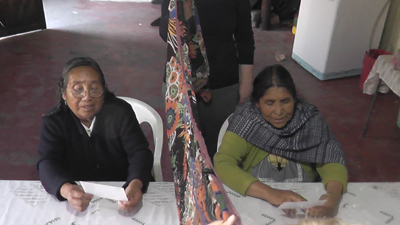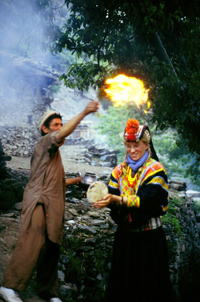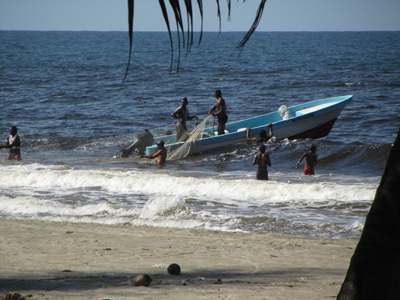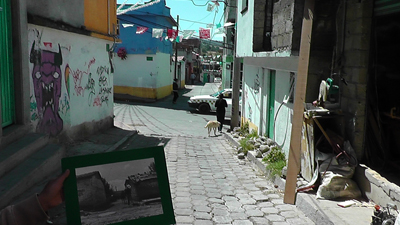Themes and questions
The three themes of the conference 1) Coding strategies, 2) Dependencies across subsystems and 3) Place-marking systems as parts of ecological and cultural niches can be addressed with questions such as the following:

Coding strategies
Place and direction information can be expressed with dedicated spatial morphemes (such as up, west), but it can also be fused with other meanings in portmanteau morphemes (e.g. come/go). Spatial information has been found to fuse with e.g. movement, placement and carrying events (Tacanan, Colonial Otomí, Kalasha). Both fusions in roots and in affixes are interesting because they suggest a recurring usefulness of providing spatial information when communicating about specific other themes, supposedly motivating their development diachronically.
-
Are there cross-linguistic preferences for fusing specific types of spatial information with other classes of meaning? Which other types of meanings are fused with place and direction information in portmanteau morphemes and why?
Spatial meanings could be fused with e.g.:
- existence (being in specific place)
- motion (moving in a specific direction or in a specific area)
- putting (placing in a specific place)
- viewing (looking in a specific direction or from a specific place)
- person (a specific grammatical person in a specific place)
- tense (at a specific time in a specific place)
- perceptual accessibility (perceptible or not at a specific place)
- preciseness (specifiable or not in a specific place)
Further, information about place and direction can be expressed both lexically (in root morphemes) and grammatically (e.g. in affixes). This implies a difference between coding spatial information as either potential foreground information or as background information (cf. Boye & Harder 2012).
-
How much do languages vary in their lexical vs. grammatical coding of place and direction information? Are specific types of spatial information preferredly presented as either foreground or background information cross-linguistically? Does this coding difference influence non-linguistic attention patterns?
When locatives are expressed with full NPs, languages often treat them as optional adjuncts, thus giving them peripheral status in the sentence. However, some languages have systematic strategies for coding source, goal and location as core arguments, tying spatial information closer to the predicate (Dimmendaal 2003).
-
How widespread are strategies to code locatives as core arguments cross-linguistically, and what motivates them? And within single languages, which types of predicates take locatives as their core arguments?

Dependencies across subsystems
Within single languages, different parts of the grammar and lexicon are responsible for expressing locational and directional meanings, e.g. nominal and verbal morphology (locative case marking, spatial conjugations), spatial adpositions, relational nouns, adverbs, landscape terms, house terms and toponyms. Further, these subsystems provide different types of spatial information, e.g. targeting spatial meanings in different scale (from microscale relations such as table-top scenarios over in-house location and in-village location to macroscale relations on a geographic level) and with or without referential anchors (topological relations vs. relations in need of a Frame of Reference (FoR)). Many of these subsystems have been examined in detail on their own, but interdependencies between them have not received the same amount of attention (but see e.g. Brown (2008) on Tzeltal, O’Meara & Pérez Báez (2011) on relationships between FoRs and meronymy in Mesoamerican languages and Levinson & Burenhult (2009) on lexical cross-domain semplates). On the one hand, spatial subsystems could divide the communicative labour among themselves and supplement or even exclude each other while on the other, they could reinforce each other, supporting similar categorization patterns across domains or scales (e.g. employing the same structuring semplate).
- If a language has obligatory verbal morphology marking direction/location (thus furthering attention to position in landscape), will the language be more likely to employ a geocentric FoR for both microscale and macroscale location predications?
- If a language marks direction or location by means of verbal morphology, will the language honour the same distinctions in nominal morphology (spatial cases)? Or do spatial verb conjugation and spatial case marking rarely co-occur because they serve similar functions?
- Do specific strategies for carving out landscape entities and labelling them with landscape terms correlate with specific systems for talking about relations between them (Topological Relation Markers, TRMs) or for orientation (Frames of Reference, FoRs)?
- Is it typical for languages to employ the same terminology and/or grammatical marking for expressing location and direction in-house, in-village and in the surrounding landscape? Which types of shared conceptualizations do correlations suggest? Can incongruences reveal translocated orientation systems – and thus yield evidence for prior migrations?

Place-marking systems as parts of ecological and cultural niches
Linguistic systems for encoding location information and for grounding utterances spatially develop in geographic areas with specific perceptual characteristics and affordances as well as challenges for human subsistence and transport. In themselves, landscapes thus invite different linguistic categorization and systems for orientation and navigation (e.g. demonstrated by Fortescue’s (2011) riverine, coastal, inland nomadic, archipelagoan and large-island systems in arctic languages), but speech communities’ cultural interaction with their physical surroundings as well as domain-general preferences in linguistic categorization also influence the ways landscapes enter language. These relationships have been especially well established for landscape terms and toponyms (cf. Burenhult & Levinson 2008, Turk et al. 2011) and orientation systems (e.g. Brown 2008, Fortescue 2011), but are also observable in directional verbal morphology (Simpson (2004) on ethnosyntax).
- How strong predictors of different location and direction marking systems are:
- Landscape types (mountainous, riverine, coastal, forestal, plains,
jungles; stable vs. variable boundaries)?
- Subsistence systems (e.g. farming, fishing, herding, hunting)?
- Settlement patterns (stable vs. nomadic, dense vs. distributed)?
- Means and purposes of travelling (on foot, riding, sailing, driving;
commerce, hunting)?
- Religious practices and myths (pilgrimages, landscape entities as settings or agents)?
 Are geocentric (geomorphic, absolute and landmark-based) FoRs as well as obligatory situal conjugation or case marking especially typical in speech communities with specific types of interaction with the landscape – such as landbased subsistence patterns, widespread travelling, ritual processions and offerings to landscape entities? Do archaeology, anthropology and ethnography yield evidence of a specific (historic and/or contemporary) preoccupation with the physical surroundings in such cultures?
Are geocentric (geomorphic, absolute and landmark-based) FoRs as well as obligatory situal conjugation or case marking especially typical in speech communities with specific types of interaction with the landscape – such as landbased subsistence patterns, widespread travelling, ritual processions and offerings to landscape entities? Do archaeology, anthropology and ethnography yield evidence of a specific (historic and/or contemporary) preoccupation with the physical surroundings in such cultures?
When grammars require speakers to attend to place and direction distinctions for communicative purposes, this attention can be routinized and used for other cognitive tasks. There is a rich experimental tradition of examining cognitive correlates for different linguistic FoRs (Levinson et al. 2002, Pederson et al. 1998) and for different topological relation markers (Bowerman & Choi 2003), but for other spatial subsystems, such as verb conjugation, nominal case marking or landscape terminology, we know less about potential co-variation of language and general cognition.
-
Which types of routine attention to the surrounding landscape does obligatory verbal place/direction conjugation (e.g. cislocative, translocative, andative) require of their speakers? How can this be investigated experimentally?
- Do cross-linguistic differences in categorizing and labelling landscape entities co-vary with cognitive differences in perceiving and categorizing boundaries and entities in a continuous landscape?

Finally, if linguistic place-marking systems require and support habitual attention to the physical surroundings in speech communities engaging with their ecological niche in culture-specific ways, such linguistic systems may be more vulnerable than other parts of the grammar in language endangerment contexts. With industrialization and globalization, many speech communities are less immediately dependent on the surrounding landscape, and traditional travel customs, routes and speed may have been supplanted (e.g. from walking on small paths or sailing in canoes to driving on roads). This can make communication about location and movement in a salient landscape less immediately useful, and in language contact situations strategies for expressing these meanings could be expected to undergo reinterpretation, simplification or loss. A different type of severance of the links between a speech community and its environment occurs when whole communities migrate or are moved forcibly to different territories. In these cases, too, place-marking systems could be especially at risk, though they could also be adapted to the speech community’s new surroundings.
- Are place-marking systems especially vulnerable in language endangerment contexts? If so, do changes in the linguistic system correlate with changes in the physical surroundings and/or communities’ habitual practices in the environment?
- Are place-marking systems in need of special attention in language revitalization context – because not only their expressions are threatened by a contact language, but the concepts they presuppose are becoming obsolete to speakers’ communicative needs?
- Can the preservation of traditional linguistic systems for reference to the physical surroundings sustain and strengthen attention to the ecosystems speech communities are part of, even in situations where everyday practices are no longer preoccupied with landscape?
- If a language with elaborate place-marking systems is replaced by another while the speech community preserves other traditional cultural practices, do speakers find ways of systematically encoding place and/or location information in the replacing language?
- What happens to locally situated place-marking systems when speech communities move –in voluntary migrations or due to forced movement?

References
Bowerman, M. & S. Choi. 2003. Space under construction: Language-specific spatial categorization in first language acquisition. In Language in mind, eds. D. Gentner & S. Goldin-Meadow, 388-427. Cambridge, MA: MIT Press.
Boye, K. & P. Harder. 2012. A usage-based theory of grammatical status and grammaticalization. Language 88,1: 1-44.
Brown, P. Up, down, and across the land: landscape terms, place names, and spatial language in Tzeltal. Language Sciences 30: 151-181
Burenhult, N. & S.C. Levinson. 2008. Language and landscape: a cross-linguistic perspective. Language Sciences 30: 135-150.
Dimmendaal, G.J. 2003. Locatives as core constituents. In Motion, Direction and Location in Languages: In honor of Zygmunt Frajzyngier, eds. E. Shay & U. Seibert, 91–109. John Benjamins Publishing Company.
Fortescue, M. 2011. Orientation Systems of the North Pacific Rim. Museum Tusculanum Press.
Levinson, S.C. & N. Burenhult. 2009. Semplates: A new concept in lexical semantics? Language 85,1: 153-174.
Levinson, S.C., S. Kita, D.B.M. Haun & B.H. Rasch. 2002. Returning the tables: language affects spatial reasoning. Cognition 84: 155-188.
O'Meara, C. & G. Pérez Báez. 2011. Spatial Frames of Reference in Mesoamerica. In Spatial frames of reference in languages of Mesoamerica, eds. C. O’Meara & G. Pérez Báez. Language Sciences 33,6: 837-852.
Pederson, E., E. Danziger, D. Wilkins, S. Levinson, S. Kita & G. Senft. 1998. Semantic typology and spatial conceptualization. Language 74,3: 557-589.
Simpson, J. 2004. From common ground to syntactic construction: associated path in Warlpiri. In Ethnosyntax: Explorations in Grammar and Culture, ed. N.J. Enfield, 288-308. Oxford University Press.
Turk, A.G, D.M. Mark & D. Stea. 2011. Ethnophysiography. In Landscape in Language: Transdisciplinary perspectives, eds. D.M. Mark, A.G. Turk, N. Burenhult & David Stea, 25-45. John Benjamins Publishing Company.

